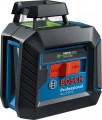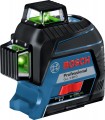Measurement range
The range at which the device remains fully operational without the use of additional receivers (see below); in other words, the radius of its action without auxiliary devices.
In some models, a range may be specified that shows the minimum (
3 cm,
5 cm) and maximum measurement ranges. But in most cases, only the maximum value is indicated.
The specific meaning of this parameter is determined by the type of instrument (see above). So, for optical levels, the measurement range is the greatest distance at which the operator can normally see the divisions of a standard leveling staff. For laser levels, this parameter determines the distance from the device to the surface on which the mark is projected, at which this projection will be easily visible to the naked eye; and in rangefinders we are talking about the greatest distance that can be measured. Typically, the measurement range is indicated for ideal conditions - in particular, in the absence of impurities in the air; in practice, it may be less due to dust, fog, or vice versa, bright sunlight "overlapping" the mark. At the same time, tools of the same type can be compared according to this characteristic.
Note that it is worth choosing a device according to the range of action, taking into account the features of the tasks that are planned to be solved with its help: after all, a large measurement range usually significa
...ntly affects the dimensions, weight, power consumption and price, but it is far from always required. For example, it hardly makes sense to look for a powerful laser level at 30-40 m if you need a device for finishing work in standard apartments.Measurement range (with receiver)
The longest measurement range provided by a laser level (see “Type”) when using a special receiver with a photocell.
Thanks to its sensitivity, such a receiver is able to respond even to a weak laser beam, the mark from which is no longer visible to the naked eye; At the same time, the area of the photocell is quite large, and special indicators make it possible to determine the exact position of the mark. Among other things, this significantly expands the range of action of the level - the measurement range with a receiver is usually several times greater than without it. On the other hand, such equipment inevitably affects the overall cost of the device; and in some models the receiver
is not included in the package at all; it must be purchased separately. However, the second option also has its advantages: you do not need to immediately pay for an additional accessory, it can be purchased later, when a real need arises, while some models allow you to choose the optimal receiver model from several options at your discretion.
Note that the receiver can be useful not only for increasing range; These points are described in detail in paragraph “Included parts”.
Accuracy
Accuracy is described as the maximum deviation from the true value of the measured parameter, which the device can give if all the rules for its operation and the corresponding measurements are observed. In both rangefinders and levels, this parameter is usually designated for a certain distance — for example, 3 mm at 30 m; but even for one manufacturer, these "control" distances may be different. Therefore, in our catalog, the accuracy of all devices is recalculated for 1 m distance; with such a record, for the example above, it will be 3/30 \u003d 0.1 mm / m. This makes it easier to compare different models with each other.
It is also worth mentioning that the meaning of the "accuracy" parameter for different types of measuring instruments (see "Type") will be different. For optical levels, it is described in the "SKP" paragraph above. For laser levels of all types, accuracy is the maximum deviation of the mark from the true horizontal (or vertical, if such a function is provided), and for the horizontal, we can talk about both moving the mark up / down and turning it. In rangefinders, this characteristic describes the maximum difference (both in "plus" and "minus") between the readings of the device and the actual distance to the object.
Anyway, the smaller the error, the better; on the other hand, accuracy significantly affects the price of the device. Therefore, it is necessary to choose a specific model for this parameter, taking into account the...specifics of the planned work. For example, for a relatively simple repair in a residential apartment, a high-precision tool is unlikely to be required; and recommendations for more complex tasks can be found in specialized sources, ranging from expert advice to official instructions.
Operating temperature
The temperature range at which the device is guaranteed to work for a sufficiently long time without failures, breakdowns and exceeding the measurement error specified in the characteristics. Note that we are talking primarily about the temperature of the device case, and it depends not only on the ambient temperature — for example, a tool left in the sun can overheat even in fairly cool weather.
In general, you should pay attention to this parameter when you are looking for a model for working outdoors, in unheated rooms and other places with conditions that are significantly different from indoor ones; in the first case, it makes sense to also make sure that there is dust and water protection (see "Protection class"). On the other hand, even relatively simple and "myopic" levels / rangefinders usually tolerate both heat and cold quite well.
Tripod thread
The standard size of the thread used to mount the level/rangefinder on a tripod (if available). This option can be useful if you already have a surveying tripod that you want to use with the tool.
The most popular options in modern devices are 1/4" and 5/8". It is worth noting that 1/4" is a standard size for
photographic equipment - accordingly, levels with such a thread can be installed even on ordinary
photographic tripods.
Auto power off
The ability
to automatically turn off the device after a certain time. This function is found in those types of measuring instruments that require power for operation — first of all, we are talking about laser rangefinders, however, this list may also include levels (see "Type"), both laser and optical with additional digital modules . The main purpose of auto-shutdown is to save electricity: after all, almost all such devices have autonomous power sources (see "Power"), the charge of which is not infinite. Forgetting to turn off the device, you may encounter an unpleasant situation: the batteries are dead, but there are no fresh ones at hand; auto-off prevents these situations and generally increases the operating time without changing batteries or recharging the battery. In addition, this feature is also useful from a safety point of view: automatic laser shutdown reduces the likelihood that its beam will accidentally fall into the eyes of someone around (including a forgetful operator).
In some models, auto-shutdown works on the entire electronics, in others it may be possible to turn off the laser first (as the most energy-intensive and unsafe part), and only after a while — all other electronic circuits.
Auto power off
The time after which the device turns off by itself completely if the user does not perform any action.
See above for more information on auto power off; and his time has a double meaning. On the one hand, if this time is short, then the idle time of the device will be minimal, which helps to save energy. On the other hand, too frequent auto-shutdown (with subsequent switching on for work) is also undesirable — it increases the wear of components and reduces the resource, and it is not always convenient for the user. So manufacturers choose the time, taking into account the balance between these moments, as well as the general class and purpose of the device. So, in some rangefinders, this indicator does not even reach a minute, although in most such devices it is in the range from 3 to 8 minutes; and in some professional devices (primarily levels), the auto-off time can be 30 minutes or more (up to 3 hours).
Vertical projections
The number of vertical projections issued by the laser level during operation.
Most modern levels are designed for a strictly defined position when working; accordingly, the
projection is called vertical, carried out from top to bottom relative to the standard position of the device. If there are several such planes, the level can be used for two or even three walls at once — this is useful, for example, for the simultaneous work of several people. At the same time, there are portable devices that can be used in different positions; for them, the main working plane is called vertical, although during operation it can be located both horizontally and at an angle, depending on specific tasks. Also note that the vertical projection can also give a horizontal line — for example, when installing a level on the floor.
Note that the number of projections is calculated not by geometric planes, but by individual laser elements, each of which is responsible for its own “work area”. For example, if the level has two vertical elements located at opposite ends and directed in different directions, they are considered as two projections even if these projections lie in the same plane.
Beam angle (vertical)
The sweep angle in the vertical plane provided by the level emitter. If there are several such radiators (for example, on both sides of the case), this parameter is given for each of them separately.
The sweep angle is, in fact, the coverage angle, that is, the width of the sector captured by the emitter when the line is formed. The wider this angle, the more convenient the device is to use, the lower the likelihood that the device will have to be moved up and down to build a line. On the other hand, a larger sweep angle (at the same range) requires more power — and this, accordingly, affects the cost and power consumption.

